Citroen JUMPER DAG 2008.5 2.G Owners Manual
Manufacturer: CITROEN, Model Year: 2008.5, Model line: JUMPER DAG, Model: Citroen JUMPER DAG 2008.5 2.GPages: 163, PDF Size: 2.56 MB
Page 91 of 163
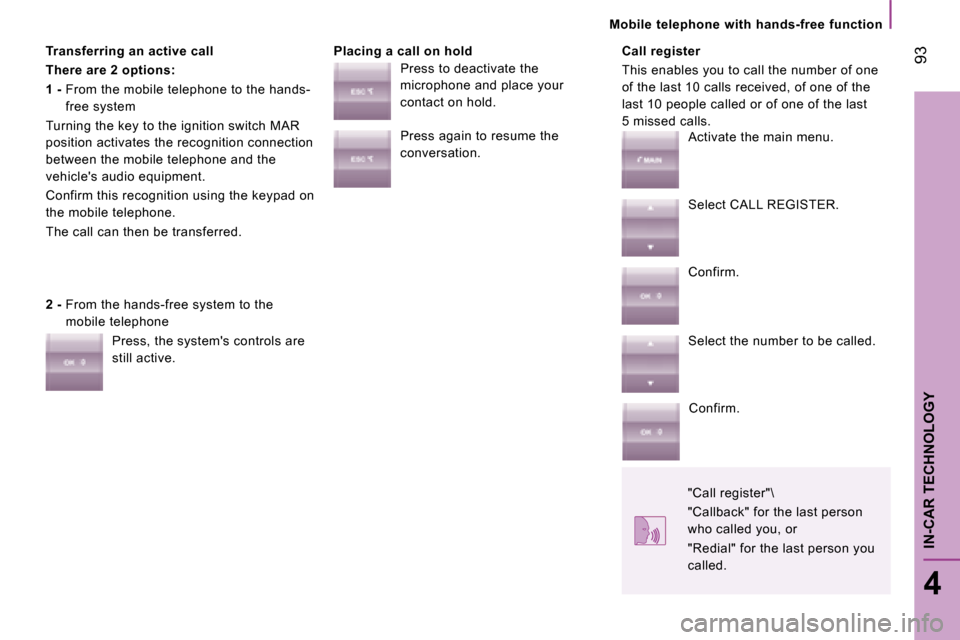
93
4
IN-CAR TECHNOLOGY
Mobile telephone with hands-free function
Transferring an active call
There are 2 options:
1 - From the mobile telephone to the hands-
free system
Turning the key to the ignition switch MAR
position activates the recognition connection
between the mobile telephone and the
vehicle's audio equipment.
Confirm this recognition using the keypad on
the mobile telephone.
The call can then be transferred. Placing a call on hold Call register
This enables you to call the number of one
of the last 10 calls received, of one of the
last 10 people called or of one of the last
5 missed calls.
2 - From the hands-free system to the
mobile telephone
Press, the system's controls are
still active. Press to deactivate the
microphone and place your
contact on hold.
Press again to resume the
conversation.
Activate the main menu.
Select CALL REGISTER.
Confirm.
Select the number to be called.
Confirm.
"Call register"\
"Callback" for the last person
who called you, or
"Redial" for the last person you
called.
Page 92 of 163
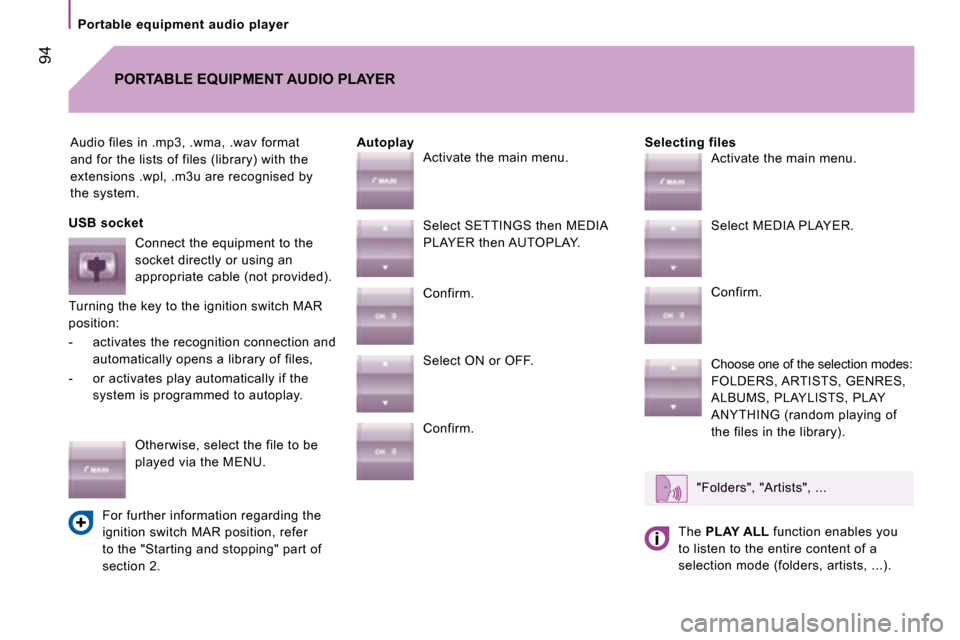
94
Portable equipment audio player
Audio files in .mp3, .wma, .wav format
and for the lists of files (library) with the
extensions .wpl, .m3u are recognised by
the system. Selecting files
PORTABLE EQUIPMENT AUDIO PLAYER
Autoplay
USB socket Connect the equipment to the
socket directly or using an
appropriate cable (not provided).
Turning the key to the ignition switch MAR
position:
- activates the recognition connection and automatically opens a library of files,
- or activates play automatically if the system is programmed to autoplay.
Otherwise, select the file to be
played via the MENU.
For further information regarding the
ignition switch MAR position, refer
to the "Starting and stopping" part of
section 2. Activate the main menu.
Select SETTINGS then MEDIA
PLAYER then AUTOPLAY.
Confirm.
Select ON or OFF.
Confirm.
Activate the main menu.
Select MEDIA PLAYER.
Confirm.
Choose one of the selection modes:
FOLDERS, ARTISTS, GENRES,
ALBUMS, PLAYLISTS, PLAY
ANYTHING (random playing of
the files in the library).
"Folders", "Artists", ...
The PLAY ALL function enables you
to listen to the entire content of a
selection mode (folders, artists, ...).
Page 93 of 163
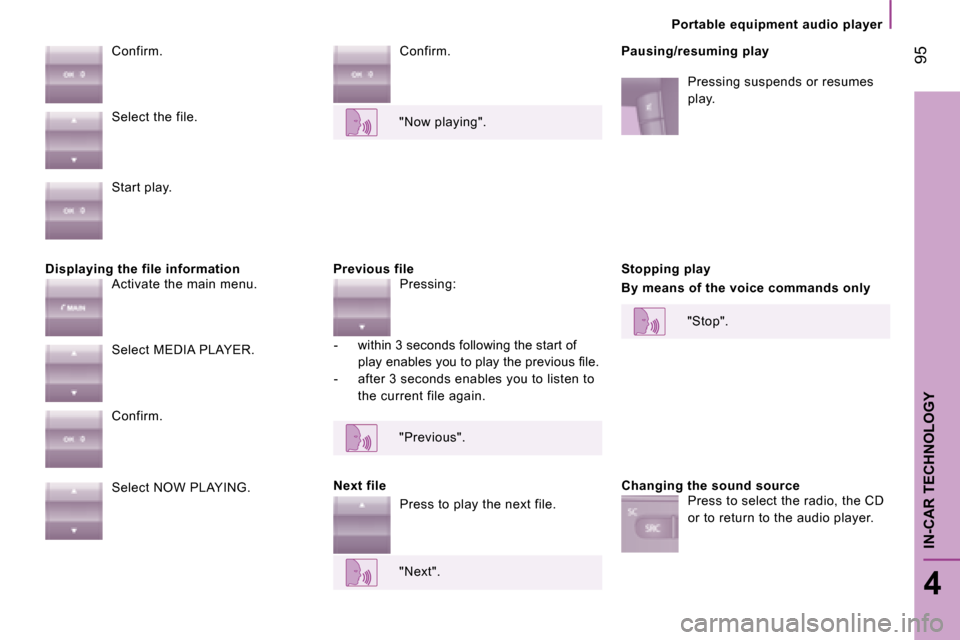
95
4
IN-CAR TECHNOLOGY
Portable equipment audio player
Displaying the file information Previous file Confirm.
Pausing/resuming play
Pressing suspends or resumes
play.
Confirm.
Next file Stopping play
By means of the voice commands only
Changing the sound source
Select the file.
Start play.
Activate the main menu.
Select MEDIA PLAYER.
Confirm.
Select NOW PLAYING.
"Now playing".
Pressing:
- within 3 seconds following the start of �p�l�a�y� �e�n�a�b�l�e�s� �y�o�u� �t�o� �p�l�a�y� �t�h�e� �p�r�e�v�i�o�u�s� �fi� �l�e�.�
- after 3 seconds enables you to listen to the current file again.
"Previous".
Press to play the next file.
"Next". "Stop".
Press to select the radio, the CD
or to return to the audio player.
Page 94 of 163
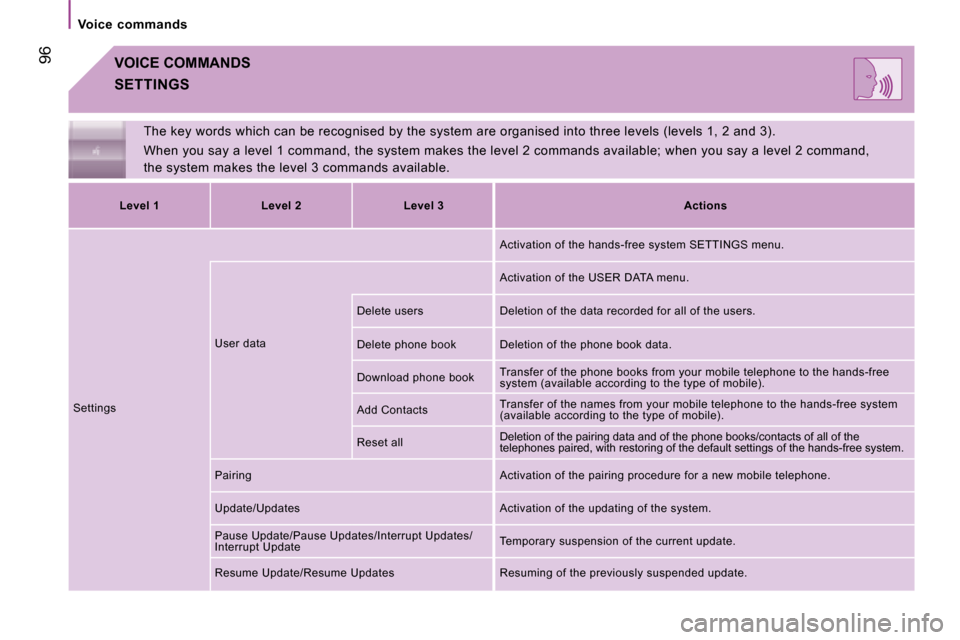
96
Voice commands
VOICE COMMANDS The key words which can be recognised by the syste m are organised into three levels (levels 1, 2 and 3).
When you say a level 1 command, the system makes t he level 2 commands available; when you say a level 2 command,
the system makes the level 3 commands available.
SETTINGS
Level 1 Level 2 Level 3
Actions
Settings User data Activation of the hands-free system SETTINGS menu.
Activation of the USER DATA menu.
Delete users Deletion of the data recorded for all of the users.
Delete phone book Deletion of the phone book data.
Download phone book Transfer of the phone books from your mobile telep
hone to the hands-free
system (available according to the type of mobile).
Add Contacts Transfer of the names from your mobile telephone t
o the hands-free system
(available according to the type of mobile).
Reset all Deletion of the pairing data and of the phone books/co
ntacts of all of the
telephones paired, with restoring of the default settings of the hands-free system.
Pairing Activation of the pairing procedure for a new mobile telephone.
Update/Updates Activation of the updating of the system.
Pause Update/Pause Updates/Interrupt Updates/
Interrupt Update Temporary suspension of the current update.
Resume Update/Resume Updates Resuming of the previ ously suspended update.
Page 95 of 163
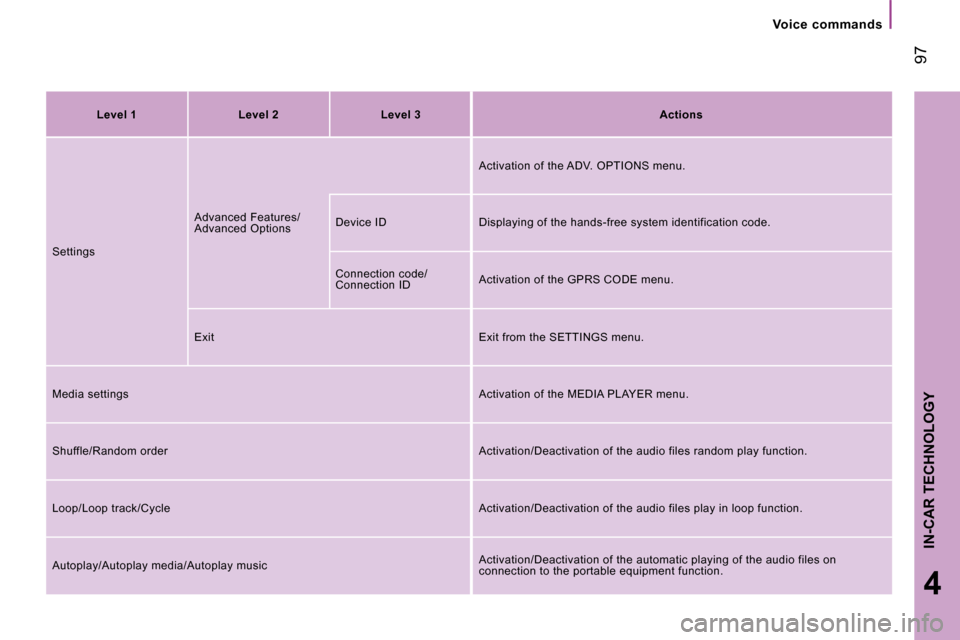
97
4
IN-CAR TECHNOLOGY
Voice commands
Level 1 Level 2 Level 3
Actions
Settings Advanced Features/
Advanced Options
Activation of the ADV. OPTIONS menu.
Device ID Displaying of the hands-free system ide ntification code.
Connection code/
Connection ID Activation of the GPRS CODE menu.
Exit Exit from the SETTINGS menu.
Media settings Activation of the MEDIA PLAYER menu.
Shuffle/Random order Activation/Deactivation of the audio files random play function.
Loop/Loop track/Cycle Activation/Deactivation of the audio files play in loop function.
Autoplay/Autoplay media/Autoplay music Activation/Deactivation of the automatic playing o
f the audio files on
connection to the portable equipment function.
Page 96 of 163
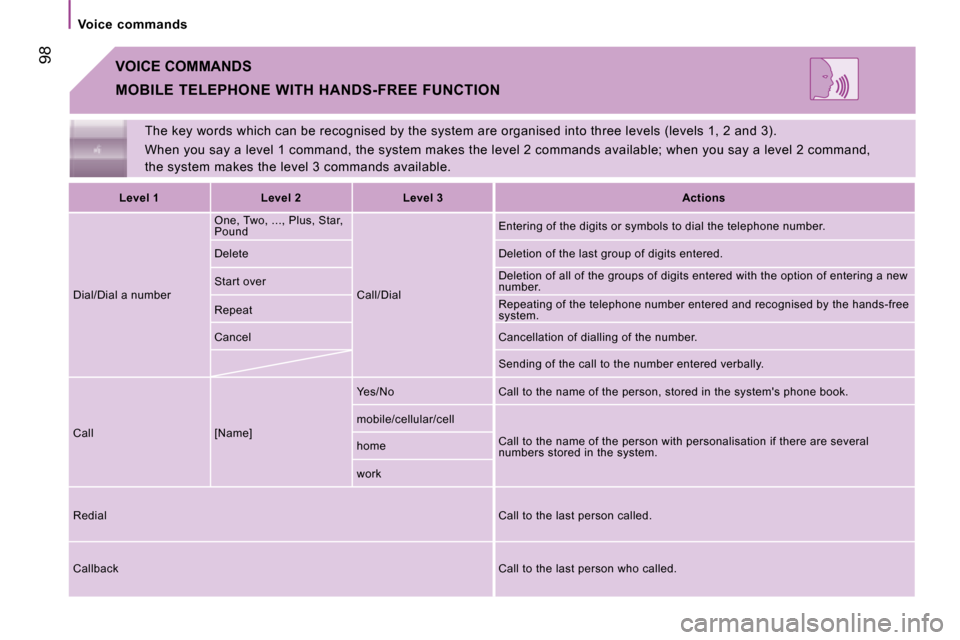
98
Voice commands
The key words which can be recognised by the system are organised into three levels (levels 1, 2 and 3).
When you say a level 1 command, the system makes t he level 2 commands available; when you say a level 2 command,
the system makes the level 3 commands available.
VOICE COMMANDS
MOBILE TELEPHONE WITH HANDS-FREE FUNCTION
Level 1 Level 2 Level 3
Actions
Dial/Dial a number One, Two, ..., Plus, Star,
Pound
Call/Dial Entering of the digits or symbols to dial the tele
phone number.
Delete Deletion of the last group of digits entered.
Start over Deletion of all of the groups of digits entered wi
th the option of entering a new
number.
Repeat Repeating of the telephone number entered and reco
gnised by the hands-free
system.
Cancel Cancellation of dialling of the number.
Sending of the call to the number entered verbally.
Call [Name] Yes/No Call to the name of the person, stored in
the system's phone book.
mobile/cellular/cell Call to the name of the person with personalisatio n if there are several
numbers stored in the system.
home
work
Redial Call to the last person called.
Callback Call to the last person who called.
Page 97 of 163
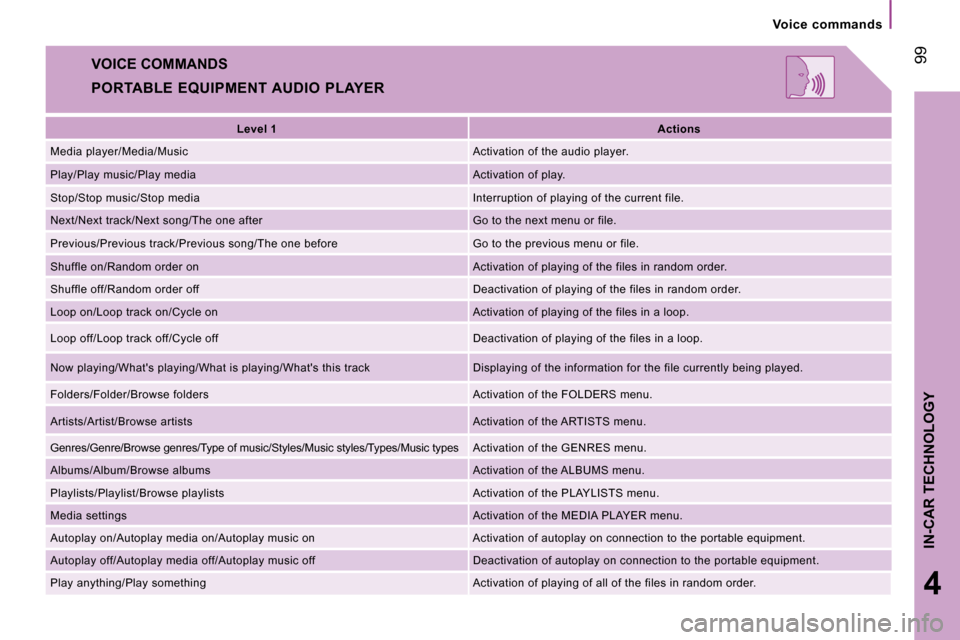
99
4
IN-CAR TECHNOLOGY
Voice commands
VOICE COMMANDS
PORTABLE EQUIPMENT AUDIO PLAYER
Level 1
Actions
Media player/Media/Music Activation of the audio player.
Play/Play music/Play media Activation of play.
Stop/Stop music/Stop media Interruption of playing of the current file.
Next/Next track/Next song/The one after Go to the next menu or file.
Previous/Previous track/Previous song/The one befo re Go to the previous menu or file.
Shuffle on/Random order on Activation of playing of the files in random order.
Shuffle off/Random order off Deactivation of playing of the files in random order.
Loop on/Loop track on/Cycle on Activation of playing of the files in a loop.
Loop off/Loop track off/Cycle off Deactivation of playing of the files in a loop.
Now playing/What's playing/What is playing/What's this track Displaying of the information for the fi le currently being played.
Folders/Folder/Browse folders Activation of the FOLDERS menu.
Artists/Artist/Browse artists Activation of the ARTISTS menu.
Genres/Genre/Browse genres/Type of music/Styles/Mu sic styles/Types/Music types Activation of the GENR ES menu.
Albums/Album/Browse albums Activation of the ALBUMS menu.
Playlists/Playlist/Browse playlists Activation of the PLAYLISTS menu.
Media settings Activation of the MEDIA PLAYER menu.
Autoplay on/Autoplay media on/Autoplay music on A ctivation of autoplay on connection to the portable equipment.
Autoplay off/Autoplay media off/Autoplay music off Deactivation of autoplay on connection to the por table equipment.
Play anything/Play something
Activation of playing of all of the files in rando m order.
Page 98 of 163
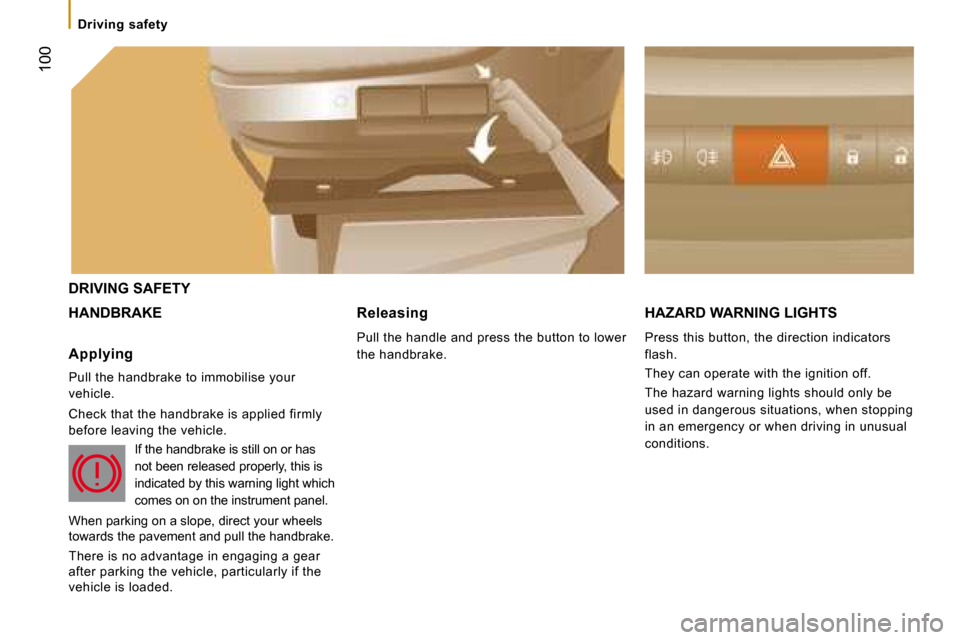
100
Driving safety
DRIVING SAFETY
HANDBRAKE HAZARD WARNING LIGHTS
Press this button, the direction indicators
flash.
They can operate with the ignition off.
The hazard warning lights should only be
used in dangerous situations, when stopping
in an emergency or when driving in unusual
conditions.
Applying
Pull the handbrake to immobilise your
vehicle.
Check that the handbrake is applied firmly
before leaving the vehicle.
If the handbrake is still on or has
not been released properly, this is
indicated by this warning light which
comes on on the instrument panel.
When parking on a slope, direct your wheels
towards the pavement and pull the handbrake.
There is no advantage in engaging a gear
after parking the vehicle, particularly if the
vehicle is loaded. Releasing
Pull the handle and press the button to lower
the handbrake.
Page 99 of 163

101
5
Driving safety
SAFETY
HORN
Press the centre of the steering wheel. ANTI-LOCK BRAKING SYSTEM
(ABS - EBFD)
The ABS and EBFD (electronic brake force
distribution) systems improve the stability
and manoeuvrability of your vehicle on
braking, in particular on poor or slippery
surfaces.
The ABS prevents locking of the wheels,
the EBFD provides full control of the braking
pressure wheel by wheel.
EMERGENCY BRAKING ASSISTANCE
SYSTEM (EBA)
In an emergency, this system enables the
optimum braking pressure to be reached
more quickly, press the pedal firmly without
releasing it.
It is triggered by the speed at which the
brake pedal is activated.
This alters the resistance of the brake pedal
under your foot.
To prolong the operation of the emergency
braking assistance system: keep your foot
on the brake pedal.
Good practice
The anti-lock braking system comes into
operation automatically when there is a risk
of wheel lock. It does not reduce the braking
distance.
On very slippery surfaces (ice, oil, etc...)
the ABS may increase the braking distance.
When braking in an emergency, do not
hesitate to press the brake pedal firmly,
without releasing the pressure, even on a
slippery surface, you will then be able to
continue to manoeuvre the vehicle to avoid
an obstacle.
Normal operation of the ABS may be felt by
slight vibration of the brake pedal.
When changing wheels (tyres and rims),
ensure that these are approved.
If this warning light comes on,
it indicates a malfunction of the
ABS which could result in a
loss of control of the vehicle on
braking.
If this warning light comes on,
together with the brake warning
light, it indicates a malfunction
of the electronic brake force
distribution which could result in a loss of
control of the vehicle on braking.
Stop immediately.
In both cases, contact a CITROËN dealer.
Page 100 of 163
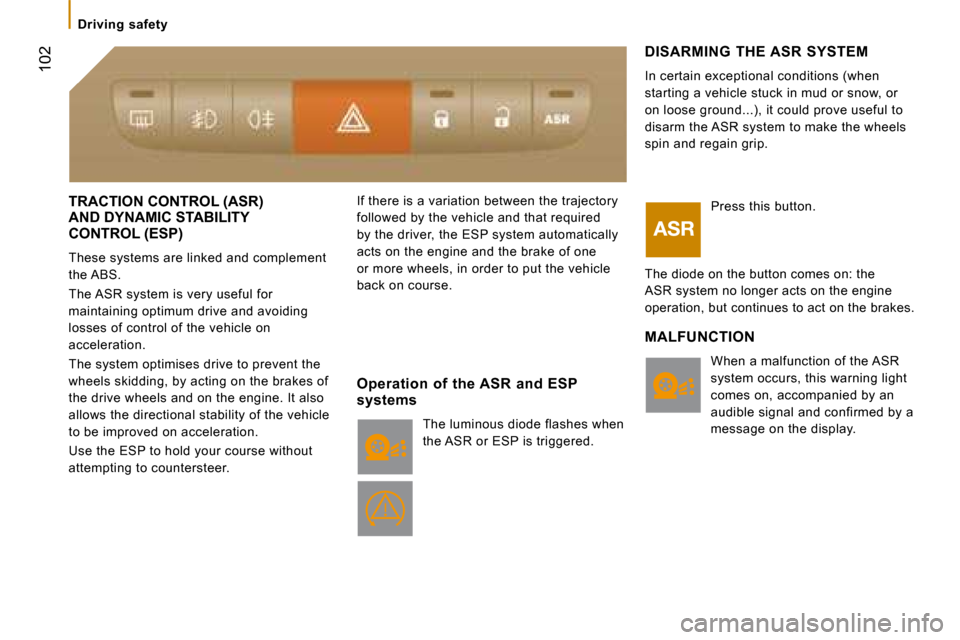
102
Driving safety
TRACTION CONTROL (ASR)
AND DYNAMIC STABILITY
CONTROL (ESP)
These systems are linked and complement
the ABS.
The ASR system is very useful for
maintaining optimum drive and avoiding
losses of control of the vehicle on
acceleration.
The system optimises drive to prevent the
wheels skidding, by acting on the brakes of
the drive wheels and on the engine. It also
allows the directional stability of the vehicle
to be improved on acceleration.
Use the ESP to hold your course without
attempting to countersteer. If there is a variation between the trajectory
followed by the vehicle and that required
by the driver, the ESP system automatically
acts on the engine and the brake of one
or more wheels, in order to put the vehicle
back on course.
DISARMING THE ASR SYSTEM
In certain exceptional conditions (when
starting a vehicle stuck in mud or snow, or
on loose ground...), it could prove useful to
disarm the ASR system to make the wheels
spin and regain grip.
Operation of the ASR and ESP
systems The luminous diode flashes when
the ASR or ESP is triggered. Press this button.
The diode on the button comes on: the
ASR system no longer acts on the engine
operation, but continues to act on the brakes.
MALFUNCTION When a malfunction of the ASR
system occurs, this warning light
comes on, accompanied by an
audible signal and confirmed by a
message on the display.